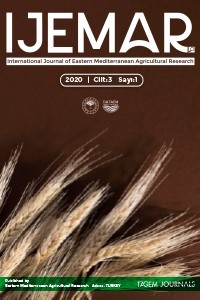Süt İneklerinin Besleme Yönetiminin Sensörlerle İzlenmesi
Hayvan davranışlarını canlı gözlemlerle izlemek, yoğun emek ve zaman isteyen zor bir görevdir. İlgilenilen konularda davranışsal verilerin uzaktan toplanması için teknolojinin kullanılması ise olası bir çözümdür. Besleme yönetimi ve sürü sağlığı için geliştirilen sensörler iş yükünün azaltılmasında ve zamandan tasarruf sağlama yanında, sürüde oluşabilecek problemlere karşı tahminleme yeteneğinin artırılıp ortaya çıkabilecek olası bir sorun için önlem alınmasında ve sorunun çözümünde ise karar vermede önemli derecede yardımcı olacaktır. Özellikle son zamanlarda süt sığırlarında beslemeyi izleme yönetimleri çoğunlukla ruminasyon takibi üzerinde yoğunlaşmıştır. Ruminasyon; akut stres, fizyolojik döneme göre metobolik problemler, rasyon kompozisyonu, yem kalitesi ve yönetim hataları da dahil olmak üzere birçok durum hakkında fikir verebilmektedir. Bu derlemede teknolojinin gelişmesiyle paralel olarak hayvancılıkta kullanılmaya başlayan sensörlerin hangi amaçla ve nasıl kullanıldığı süt sığırlarının besleme yönetimi açısından değerlendirilmiştir.
Anahtar Kelimeler:
Ruminasyon, süt sığırı, besleme, sensörler, hastalık
Monitoring of Feeding Management of Dairy Cows with Sensors
Watching animal behavior through live observations is a difficult task that requires labor and time. Using technology to remotely collect behavioral data on issues of interest is a possible solution. Sensors developed for feeding management and herd health will be an important aid in reducing workload and saving time, as well as increasing the ability to predict the problems that may occur in the herd and taking measures for a possible problem that may arise, and in terms of decision-making in solving the problem. In dairy cattle, especially recently, management of monitoring feeding has focused on rumination monitoring. Rumination; It can provide insight into many conditions, including acute stress, metabolic problems relative to physiological period, ration composition, feed quality, and management errors. In this review, the purpose and how the sensors used in animal husbandry are used in parallel with the development of technology are evaluated in terms of feeding management of dairy cattle.
Keywords:
rumination, dairy cattle, feed, sensors, disease,
___
- Alamouti, A. A., M. Alikhani, G. R. Ghorbani, A. Teimouri-Yansari, And M. Bagheri. 2014. Response of Early Lactation Holstein Cows to Partial Replacement of Neutral Detergent Soluble Fibre For Starch in Diets Varying In Forage Particle Size. Livest. Sci. 160:60–68. Https:// Doi .Org/ 10 .1016/ J .Livsci .2013 .12 .009.
- Ambriz-Vilchis, V., N. S. Jessop, R. H. Fawcett, D. J. Shaw, And A. I. Macrae. 2015. Comparison Of Rumination Activity Measured Using Rumination Collars Against Direct Visual Observations And Analysis Of Video Recordings Of Dairy Cows In Commercial Farm Environments. J. Dairy Sci. 98:1750–1758. Https:// Doi .Org/ 10 .3168/ Jds .2014 -8565.
- Bailey, C. B., And C. C. Balch. 1961. Saliva Secretion And Its Relation To Feeding In Cattle. 2. The Composition And Rate Of Secretion Of Mixed Saliva In The Cow During Rest. Br. J. Nutr. 15:383–402. Beauchemin, K. A., And L. Rode. 1994. Compressed Baled Alfalfa Hay For Primiparous And Multiparous Dairy Cows. J. Dairy Sci. 77:1003– 1012. Https:// Doi .Org/ 10 .3168/ Jds .S0022 -0302(94)77036 -3.
- ISSN: 2667-5102
- Yayın Aralığı: Yıllık
- Başlangıç: 2018
- Yayıncı: Eastern Mediterranean Agricultural Research Institute
Sayıdaki Diğer Makaleler
Süt Sığırcılığında Sürdürülebilirlik için Sıcak Koşullarda Alınacak Önlemler
Süt İneklerinin Besleme Yönetiminin Sensörlerle İzlenmesi
Atalay ERGÜL, Şerife ERGÜL, Uğur SERBESTER
Mehmet KÜÇÜKYILMAZ, Mehmet Ali Turan KOÇER, Gürel ÖRNEKÇİ, Gökhan KARAKAYA, Ali USLU, Gülden ARISOY, Kenan ALPASLAN, İbrahim TÜRKGÜLÜ, Nurten ÖZBEY
Ana Ürün Koşullarında Bazı Şeker Mısır Genotiplerinin Verim ve Verim Unsurlarının Belirlenmesi
